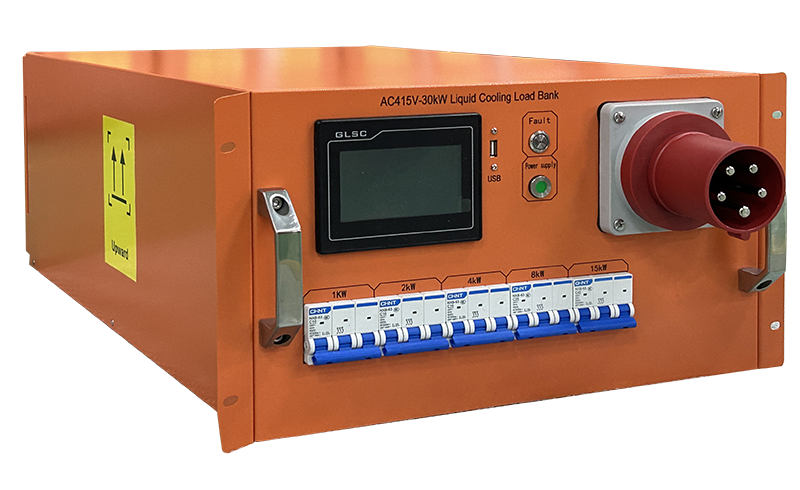Liquid Cooled Load Bank vs. Air Cooled Load Bank: A Comparison of Heat Dissipation Efficiency, Energy Cost, and Applicable Scenarios
Time:2025-08-21
As the computing density of data centers continues to rise, chip power consumption has surged from the hundred-watt level to the kilowatt level, making heat dissipation technology a core bottleneck restricting system performance. Liquid Cooled Load Banks and air-cooled load banks, as mainstream cooling solutions, differ significantly in technical principles, practical performance, and applicable scenarios. This article compares the two from three dimensions—heat dissipation efficiency, energy consumption cost, and applicable scenarios—to provide reference for cooling technology selection in different scenarios.
I. Heat Dissipation Efficiency: A Leap from "Air Conduction" to "Liquid Conduction"
The core difference in heat dissipation efficiency stems from the physical properties of heat transfer media. The thermal conductivity of air is approximately 0.026 W/(m·K), while that of water reaches 0.6 W/(m·K), and insulating coolants such as mineral oil can reach 0.14 W/(m·K). Liquids have far superior heat transfer capabilities than air, leading to substantial differences in heat dissipation efficiency between the two technologies.
(1) Gap in Heat Dissipation Power Density
Air-cooled load banks rely on fans to drive air flow through heat-generating components. Limited by air’s low thermal conductivity and flow resistance, their heat dissipation power density is generally low. Conventional air-cooled systems typically achieve 50-100 W/cm², and even with high-density fan arrays and optimized air duct designs, the limit rarely exceeds 200 W/cm². This means when chip power consumption exceeds 300 W, air-cooled systems are prone to insufficient cooling, causing chip throttling or even shutdowns.
Liquid Cooled Load Banks, leveraging liquids’ efficient heat transfer capabilities, achieve a qualitative leap. Cold-plate liquid cooling, through direct contact between metal cold plates and chips, reaches a heat dissipation power density of 300-500 W/cm²; immersion liquid cooling, which submerges equipment in insulating coolant via phase change or convection, can exceed 1000 W/cm². In AI server GPU clusters with single-card power consumption of 400-800 W, Liquid Cooled Load Banks stably control chip temperatures below 85°C, while air-cooled systems often require multiple fan overlays but still struggle to avoid local overheating.
(2) Differences in Temperature Uniformity
Air flow distribution in air-cooled systems is easily affected by cabinet layout and equipment arrangement, leading to cooling blind spots. For example, the temperature difference between the top and bottom of servers can reach 5-8°C, and deviations between edge and central equipment may exceed 10°C. Temperature unevenness accelerates the aging of electronic components.
Liquid Cooled Load Banks achieve more uniform temperature distribution through forced circulation or natural convection of liquids. In cold-plate liquid cooling, stable coolant flow in pipelines controls temperature differences between chips within 3°C; in immersion liquid cooling, the overall temperature gradient of coolant is smaller, with typical temperature differences within a single cabinet of less than 2°C. This uniformity is crucial for large-scale clusters in supercomputing centers, reducing system stability issues caused by temperature fluctuations.
II. Energy Consumption Cost: A Trade-off Between Short-Term Investment and Long-Term Returns
The cost of cooling systems includes not only initial equipment procurement but also full-lifecycle energy consumption and maintenance expenses. Liquid Cooled and air-cooled load banks show distinct cost structures: "high upfront investment vs. high long-term consumption."
(1) Initial Construction Cost
Air-cooled load banks primarily consist of fans, air ducts, and temperature control modules. With mature technology and well-established supply chains, the cooling cost per cabinet ranges from 1,000 to 3,000 RMB. For small and medium-sized data centers, air-cooled systems can be installed without large-scale modifications, directly adapting to existing cabinet layouts, resulting in low initial investment thresholds.
Liquid Cooled Load Banks have more complex cost structures. Cold-plate liquid cooling requires customized cold plates, circulation pumps, and heat exchangers, with per-cabinet costs of 8,000-15,000 RMB; immersion liquid cooling, requiring coolant, sealed cabinets, and phase-change recovery devices, can reach 20,000-50,000 RMB per cabinet. Additionally, liquid cooling systems have specific requirements for room layout and load-bearing capacity, requiring additional infrastructure investment for new or renovated machine rooms, further increasing initial costs.
(2) Long-Term Energy Consumption and Maintenance Costs
Air-cooled systems consume energy mainly through fan operation, with fan power accounting for 15%-20% of total data center energy consumption under high loads. For a 1,000-cabinet data center, annual electricity costs for air-cooled solutions can reach hundreds of thousands of yuan. Moreover, high fan speeds cause noise pollution (usually exceeding 75 decibels), requiring additional sound insulation measures.
Liquid Cooled Load Banks concentrate energy consumption in circulation pumps and heat exchangers, with power consumption only 30%-50% of air-cooled systems. Cold-plate liquid cooling accounts for approximately 5%-8% of total power consumption, while immersion liquid cooling, utilizing natural cold sources (e.g., cooling towers), can reduce this to below 3%. Long-term, liquid cooling systems achieve significant electricity savings—for a 1,000-cabinet data center, annual energy costs can decrease by over 50%.
In terms of maintenance, air-cooled systems require regular filter cleaning and fan replacement (average lifespan 3-5 years), with annual maintenance costs accounting for 5%-8% of initial investment. Liquid cooling systems need pipeline leakage detection and coolant replacement (lifespan 5-8 years), with maintenance costs at 3%-5%. Although single maintenance is more complex, the lower frequency results in more advantageous full-lifecycle costs.
III. Applicable Scenarios: Adaptation Logic from "Power Demand" to "Environmental Constraints"
The application scenarios of the two cooling technologies are not mutually exclusive but determined by multiple factors such as power density, cost sensitivity, and environmental conditions.
(1) Core Applicable Scenarios for Liquid Cooled Load Banks
High Power Density Scenarios: When power per cabinet exceeds 20 kW in AI servers or supercomputing centers, air-cooled systems struggle to meet cooling needs, making liquid cooling a necessity. For example, GPU cluster cabinets for training large AI models, with power of 50-100 kW, must rely on cold-plate or immersion liquid cooling for stable operation.
Energy-Saving and Low-Noise Requirements: Liquid cooling’s low energy consumption 优势 is significant when data centers need to meet green and low-carbon standards. Additionally, in noise-sensitive environments such as medical facilities and research institutions, liquid cooling systems (operating noise typically below 55 decibels) can replace high-noise air-cooled solutions.
High-Temperature Environments: In tropical regions or unairconditioned machine rooms where ambient temperatures often exceed 35°C, air-cooled efficiency drops sharply, while liquid cooling systems remain stable with minimal environmental impact.
(2) Core Applicable Scenarios for Air-Cooled Load Banks
Medium-Low Power Density Scenarios: Air-cooled systems sufficiently meet cooling needs for small/medium data centers and edge computing nodes with per-cabinet power below 10 kW. For example, enterprise server cabinets with 5-8 kW power adopt air cooling to reduce initial investment.
Cost-Sensitive Scenarios: Air cooling’s low initial cost is more attractive for budget-constrained scenarios, such as small machine rooms or temporary computing expansion projects, avoiding high liquid cooling construction costs in the short term.
Rapid Deployment Scenarios: Air-cooled systems have short installation and commissioning cycles (usually 1-2 weeks per cabinet), suitable for fast-track projects. In contrast, liquid cooling systems involve complex pipeline laying and leak testing, with deployment cycles of 1-3 months.
IV. Future Trends: Collaborative Integration and Technological Iteration
With the diversification of computing demands, liquid cooling and air cooling are not substitutes but show collaborative development trends. Some data centers adopt hybrid "liquid + air cooling" schemes: core high-power equipment uses liquid cooling, while edge low-power devices use air cooling, balancing cost and efficiency.
In technological iteration, Liquid Cooled Load Banks are developing toward "low-concentration coolants" and "intelligent leak monitoring" to reduce costs and improve safety; air-cooled systems optimize energy consumption through "variable frequency fans" and "AI air volume adjustment," expanding applicable boundaries. Future cooling technology selection will become more refined, achieving optimal matching based on specific scenario power requirements, cost budgets, and environmental constraints.
News Recommendation
-
 2024-09-11
2024-09-11TRIUMPH LOAD EXHIBITING AT Enlit Europe 2024 -BOOTH 7.H08
-
 2023-04-21
2023-04-21TRIUMPH LOAD EXHIBITING AT DATA CENTER WORLD GERMANY 2023-BOOTH F909
-
 2023-04-06
2023-04-06TRIUMPH LOAD EXHIBITING AT ELECTRIC POWER TECH KOREA 2023 – Booth G109
-
 2022-05-05
2022-05-05What is the role of ac load bank for power supply?
-
 2022-05-05
2022-05-05What is the role of the load bank?


